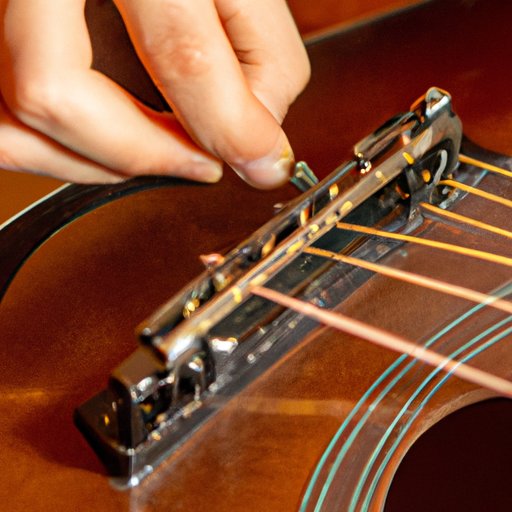I. Introduction
Stringing your guitar may seem like a daunting task, but with a little know-how, it can be a simple and rewarding process. Whether you’re a seasoned pro or a rookie with your first guitar, this comprehensive guide will provide you with the information you need to achieve the perfect sound. In this article, we’ll cover the tools and techniques needed for proper stringing, as well as tips and tricks for maintaining your instrument’s sound over time.
II. Step-by-Step Guide: How to String Your Guitar for Perfect Sound
The key to achieving the perfect sound when stringing your guitar is taking your time and following a proper process. Here’s a step-by-step guide to help you through the process:
1. Remove the old strings from your guitar by unwinding them from the tuning pegs.
2. Clean your guitar and fretboard with a soft cloth to remove any dirt or debris.
3. Take your new guitar strings and insert one end into the bridge of your guitar. String it through the hole and guide it up to the appropriate tuning peg.
4. Wind the string around the peg and tune it to pitch using a guitar tuner.
5. Repeat steps 3-4 for the remaining strings.
6. Finally, trim the excess string using wire cutters or scissors.
By following these simple steps, you can achieve the perfect sound from your guitar. Remember to take your time and ensure that each string is properly tuned before moving on to the next.
III. The Do’s and Don’ts of Guitar Stringing: A Beginner’s Guide
While stringing your guitar may seem like a straightforward process, there are some common mistakes that beginners should avoid. Here are some do’s and don’ts to keep in mind when stringing your guitar:
Do:
- Use the appropriate gauge of strings for your guitar
- Ensure that the strings are properly seated in the bridge
- Stretch out your strings before tuning to help prevent them from slipping out of tune
- Properly cut the excess string after stringing
Don’t:
- Overtighten your guitar strings, as this can damage your guitar or cause your strings to break prematurely
- Install strings in the wrong order
- Reuse old strings
- Leave excess string on your guitar
By following these do’s and don’ts, you can avoid common mistakes and achieve the perfect sound from your guitar.
IV. Reviving Your Guitar’s Sound: Tips for Re-Stringing and Maintenance
Over time, your guitar’s strings will wear down, causing a decline in the quality of your sound. But by regularly re-stringing your guitar and maintaining it properly, you can help preserve and enhance its sound. Here are some tips for re-stringing and maintaining your guitar:
1. Re-string your guitar every three to six months, depending on your playing frequency.
2. Clean your strings and fretboard regularly to prevent buildup.
3. Store your guitar in its case or a safe, dry location when not in use.
4. Protect your guitar from extreme temperatures and humidity.
5. Have your guitar regularly serviced by a professional technician to ensure that it’s in optimal condition.
By following these tips, you can help preserve and enhance your guitar’s sound over time.
V. DIY Guitar Stringing: How to Avoid Costly Repairs by Learning to Do It Yourself
Stringing your own guitar is not only a rewarding process, but it can help you avoid expensive repairs down the road. Here’s a step-by-step guide for novice guitar stringers:
1. Gather the necessary tools, including a string winder, wire cutters or scissors, and new guitar strings.
2. Follow the step-by-step guide provided in section II above.
3. Once all of the strings are strung, tune your guitar and test the sound.
4. If you encounter any problems, consult the do’s and don’ts outlined in section III, or seek advice from a professional technician if needed.
By taking the time to string your own guitar and maintain it properly, you can avoid costly repairs and unleash your inner guitarist.
VI. The Art of Guitar Stringing: Tips from the Pros
Whether you’re a seasoned pro or a beginner, it’s always helpful to learn from the masters. Here are some tips from professional guitar players and technicians:
1. Use a high-quality set of strings that’s appropriate for your guitar and playing style.
2. Stretch out your strings before tuning to prevent slips in tuning.
3. Experiment with different gauges of strings to find the perfect sound for your playing style.
4. Regularly clean your guitar and strings to prevent buildup.
5. Have your guitar regularly serviced by a professional technician for optimal sound and performance.
By following these tips from the pros, you can improve your guitar stringing skills and achieve the perfect sound.
VII. Conclusion
Stringing your guitar can seem like a challenging task, but with this comprehensive guide, you can achieve the perfect sound by taking your time and following proper technique. Whether you’re a beginner or a seasoned pro, stringing your own guitar can be a rewarding experience that helps you unleash your inner musician. By following these tips and best practices, you can maintain your guitar’s sound over time and avoid costly repairs.
